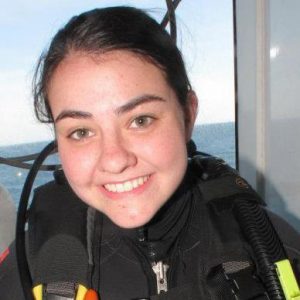Drifting with the Tides: A New Beginning
Master’s student Gabrielle “Gabby” Hillyer, a dual-degree oceanography and marine policy major, has spent the last three years conducting research on the Medomak River in Waldoboro, Maine taking measure of the tides using small “bucket drifters” packed with scientific instruments.
The research is aimed at better understanding the dynamics of the estuary’s ability to flush out harmful bacteria that, in the wake of rainstorms of more than an inch, close clam flats for a mandatory nine-day period per state regulations. In such cases, most of the Medomak is off limits to the 175 licensed shellfish harvesters, which can cause economic hardship for extended periods of time.
Over the course of the project Hillyer has worked closely with commercial clammer Glen Melvin, who is also vice-chair of the Waldoboro Shellfish Committee and sits on the Maine Shellfish Advisory Council.

As her drifter work winds down, Hillyer is preparing to defend her Master’s thesis. She is also drafting reports for the Maine Department of Marine Resources (DMR), the Maine Department of Environmental Protection, and the Medomak Task Force.
“By examining tidal trends more thoroughly, we can better understand how pollution closures work and how clammers might be affected by them,” Hillyer says.
She notes that the drifter work has already shifted ideas of what she, Melvin and others thought they’d find in the estuary. For example, “We learned that wind is an important factor that transports bacteria into clam flats, particularly during slack tides. And that has a lot of ramifications for how the DMR manages the closures due to pollution,” she says.
Further, Hillyer says, the work has demonstrated how small, “easy” projects can have a lot of impact. “These drifters are not very expensive and you don’t have to be super tech savvy to use them. And it also has given the community, the stakeholders, a tool to really understand how pollution can be concentrated in certain areas in the estuary due to how the water circulates in different places.”
Although Hillyer’s work with the drifters is winding down, she says another follow-on project with colleagues in and beyond the Mitchell Center will take the work further using acoustic doppler technology to examine tidal currents more precisely. Lauren Ross, along with Mitchell Center members Sean Smith, Bridie McGreavy, Samuel Roy and Hillyer, will be deploying Acoustic Doppler Current Profilers in the Medomak. “This technology, together with a more advanced hydrodynamic model, will give us a much more accurate picture of water movement than my drifters were able to provide,” Hillyer says.
As a measure of just how valued Hillyer’s work has been viewed by the stakeholders in Waldoboro, they have asked her to participate in a different project on the Medomak that involves seeding recently opened clam flats with larval clams. About 360 acres of clam flats have been reopened as pollution has been slowly mitigated, which has allowed the clamming community to shift their focus to increasing the clam population.
“I was asked to help them with different seeding projects, and it’s exciting to be invited to stick around,” says Hillyer
Glen Melvin notes, “Gabby’s drifter model results will be used in the future by the Medomak project to pursue pollution-related issues. We look forward to working with her to see if the drifters not only show current flow for pollution, but also the flow of clam seed throughout the river.” Melvin adds, “Gabby’s expertise will be used to place the new clam seed beds in strategic locations.”
Speaking of “sticking around,” Hillyer recently decided to pursue a Ph.D. in Ecology and Environmental Sciences at UMaine once she has completed her Master’s degree.
“When I move into the Ph.D. program, the drifter project will be the first cornerstone in a larger project for my doctorate degree. The Mitchell Center’s emphasis on creating deep, productive and reciprocal stakeholder relationships will continue to be the foundation for my work in Maine.”
—David Sims
